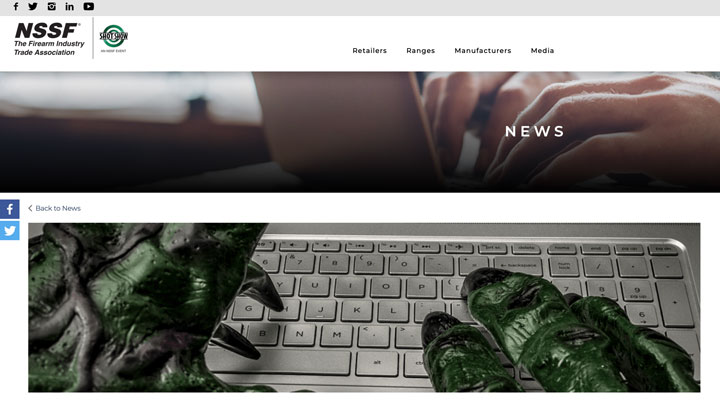
by Jay Pinsky, Editor, The Hunting Wire - Friday, April 22, 2022

The Internet is dangerous for us, our wallets and our sanity. People mislead us, lie to us and manipulate us to take our money, suppress our opinions and incite disagreement amongst otherwise friendly groups. It impacts us as hunters, consumers, retailers and private citizens. It hurts our sporting lives, professional lives and, yes, our personal lives. There’s no debating the existence of digital predators so let’s take some space in our collaborative Voice of Leadership Panel to educate and inform us all about information manipulation. We’ll start with the basics and then apply our knowledge to our digital lives.
So, what is misinformation, disinformation and malinformation? According to the Department of Homeland Security’s Cybersecurity and Infrastructure Security Agency (CISA), “Misinformation misleads. It is false but not created or shared to cause harm. Disinformation deceives. It is deliberately created to mislead, harm or manipulate a person, social group, organization or country. Malinformation sabotages. It is based on fact but used out of context to mislead, harm or manipulate.”
We can imagine many scenarios where these three words apply. From Facebook feeds to newspaper articles, what we say helps define who we are and what people think about critical issues and each other. What is said to us maybe impacts us even more so. In 2020 the National Shooting Sports Foundation published the article “Fighting Social Media’s Trolls—and Coming out Smelling Like a Rose,” to help firearms industry folks combat social media misfits.

Ah, social media. There are fake people out there. No, I mean fake as in they’re not people. They’re “bots.” What’s a social media bot, and why do I care?
According to CISA, social media bots are automated programs that simulate human engagement on social media platforms. They use artificial intelligence and other programs to masquerade as legitimate users. Varying in terms of function and capability, CISA explains, “Some are helpful, like chat bots and automated notifications, but some can be used to manipulate real users. When misused, bots can amplify disinformation and distort our perception of what's important, even shutting down online conversations.”
Like most anything else, there are good bots and bad ones. According to CISA, good ones provide the following:
Bad bots harm us through:
While infesting our news feeds, social media bots do the following:
When it comes to spotting a bot, CISA recommends we consider the following:
Other ways we can be victimized on the Internet include the use of fake websites, forgeries and manipulated media. As for what is a fake or proxy site, CISA says proxy websites are fronts for malicious actors designed to launder disinformation and/or to drive website visits. Following high-visibility events, they arise to take advantage of the public's legitimate desire for information. Be cautious of sites that have unclear origins or misspellings in a URL.
I recently spoke with Weatherby's Zach Hein regarding his concerns about fake websites seeking to take advantage of unsuspecting Weatherby customers. “We've been urging our customers to be very sure that they're visiting and purchasing from weatherby.com,” he said. “There are spoof sites out there whose entire goal is to fool people into thinking they’re on our site.”
With similar spoof sites present for more than a dozen companies across the firearms industry, Hein added that other industry partners have had similar fraud issues. In alerting Weatherby customers to the dangers of fake websites, he said, “The biggest red flag for a con of this type is the method of payment. At Weatherby, we'll only take payment online through a secure credit card processor, while the spoof sites tend to ask for payment in cryptocurrency or through money transfer apps like Zelle.”
As for other inconsistencies, Hein said they range from the use of outdated logos to long-discontinued products being “in stock” to seeing rifles by makers other than Weatherby pictured. After reaching out to Mark Oliva, the National Shooting Sports Foundation’s public affairs director, to alert him to what Weatherby was experiencing, NSSF issued the following NSSF Member Alert:
“NSSF has learned from several industry firearm, ammunition and propellant manufacturers of bogus websites and web scams aimed at consumers who are eager to purchase these high-demand products. NSSF warns consumers to take steps to confirm the websites they are using are legitimate. If you believe you have been the victim of a fraudulent transaction, NSSF encourages you to contact the FBI, ATF or file a complaint with the Federal Trade Commission either online or by calling 800-382-4357 (800-FTC-HELP). For additional information, click here to visit the official U.S. government website providing tips for online safety and Internet fraud.
CISA warns that another tactic is the use of forged digital communications, defining forgeries as artifacts featuring fake letterheads, copied and pasted signatures, made-up social media posts and maliciously edited emails. They are often presented as being obtained through hacking and are being shared as “leaked” materials, often packaged with authentic content to lend credibility. If the forgery appears to be groundbreaking news, check reputable news sites to see if they covered the event.
One instance of this was a series of emails I received from what appeared to be the Virginia Department of Wildlife Resources (DWR). Fortunately, I reached out to DWR Executive Director Ryan Brown for clarification.
Sharing how his agency addressed the issue, Brown explained, “This past winter, we and other state fish and wildlife agencies saw our licensees marketed to under the auspices of partnerships that weren't legitimate. We quickly enlisted the help of our state's Attorney General’s Office and were successful in getting the activity to stop.” Brown said the DWR let constituents know through media and social media that the solicitations they were receiving weren't from the DWR, starting with posting a news release on its website on Feb. 15.
Just as in dealing with banking or retail sales online, there is a need to be vigilant. “When it comes to license purchases or other transactions, those are always conducted through our official websites or our agency app, and I believe other state fish and wildlife agencies are the same,” he said. “We won't ask you to purchase a license through any other site, so come straight to the agency when you're ready to head to the field.”
Unfortunately, criminals don't stop with emails. Online we see all kinds of fake and manipulated forms of media, from altered gun images to digitized video edits of speeches.
So, what is manipulated audio/video? CISA explains that audio/video content often goes viral because, though it is false, it grabs the audience's attention and is shared. But what if this content is a “cheapfake” or “deepfake?” Cheapfakes are real audio clips and videos that have been sped up, slowed or shown out of context to mislead. Deepfakes are fake but believable audio clips and videos spread to deceive. They can convince you that people have said or done things that did not happen. Visual deepfakes can generate fake-but-plausible faces or full-body video. An audio deepfake can be a voice clone that produces new sentences from one person or multiple people. Some fakes are more easily detectable while uncovering others requires special software. Check with sources to confirm authenticity.
The Internet should be an excellent source of social connection, marketing, education and commerce—and it is. But it also attracts criminals and disrupters who can wreak havoc on our peace of mind and our wallets. I hope the information presented here helps you avoid becoming a victim of Internet trolls and hacks.
For more information, visit the CISA website.
2021-2022 The Hunting Wire Voice of Leadership Panel
The Voice of Leadership Panel is a group of outdoor industry leaders who have volunteered to address key hunting and outdoor recreation issues. Panelists include:
Facilitators
E-mail your comments/questions about this site to:
[email protected]
Proudly supported by The NRA Foundation and Friends of NRA fundraising.
